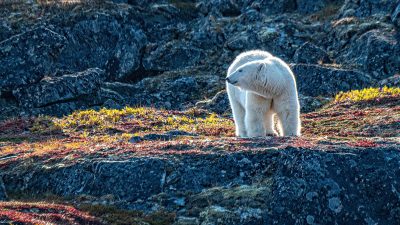Many Ways to Say, “Thank You!”
Just like other languages, Inuktitut has several dialects that vary by geographic region. The Inuktut language family spans from Alaska in the west to Greenland in the east and down south along the coast of Labrador. Depending where you’re travelling to, there can be different ways of communicating the same idea.
One of the most common phrases visitors want to learn is, “Thank you!” It is best to thank someone in the dialect they speak.
Inuinnaqtun dialect: in western Nunavut (including Kugluktuk), say quana [KWAH – nah]
North Qikiqtaaluk dialect: in northern Baffin Island (including Mittimatalik), say qujannamiik [KOO – yah – nah – MEE]
South Qikiqtaaluk dialect: in southern Baffin Island (including Kinngait), say nakurmiik [nah – koor – MEEK]
Nunatsiavummiutut dialect: in northern Labrador (including Nain), say nakummek [nah – koo – MEEK]
Kalaallisut (Greenlandic): in southwestern Greenland (including Ilulissat), say qujanaq [koo – yah – NAHK]
Greetings
Did you know that historically there was no direct translation for “hello” in Inuktitut? It’s more common to greet people according to the time of day. You can also smile and raise your eyebrows as a silent way of saying hello.
South Qikiqtaaluk dialect:
- Ullaakkut [oohl – LAH – koot] = "Good morning"
- Unnusakkut [OOH – nooh – sah – koot] = "Good afternoon"
- Unnukkut [OOHN – noohk – koot] = "Good evening"
Nunatsiavummiutut dialect:
- Ullâsiak [oohl – LAH – see – ahk] = "Good morning"
- Ullusiak [oohl – LOO – see – ahk] = "Good afternoon"
- Unnusatsiak [OOHN – noo – sah – tsee – AHK] = "Good evening"
Questions & Answers
Non-verbal communication is an important part of Inuktitut. It is common for Inuit to reply to a question by raising their eyebrows (yes) or by scrunching their nose and forehead (no).
North Qikiqtaaluk dialect:
- Kinauvit? [kee – NOW – vee] = "What’s your name?"
- ____ujunga. [your name + ooh – YOONG – ah] = "My name is ____."
- Qanuippit? [kah – noohEEP – peet] = "How are you?"
- Qanuinngittuq. [kah – noohING – ee – tuhk] = "I’m fine."
Inuinnaqtun dialect:
- Kinauvit? [kih – NOW – vit] = "What’s your name?"
- ____ujunga. [your name + ooh – YOONG – ah] = "My name is ____."
- Qanuritpit? [kah – noohr – IT – pit] = "How are you?"
- Qanurinngi. [kah – noohr – ING – ee] = "I’m fine."
A Note on the Word Inuit
Inuit is an Inuktitut word that means “people.” For this reason, when talking about Inuit as a group or culture, we don’t say “Inuit people”—just Inuit. Similarly, because Inuit is already plural, we don’t add s to the end of the word as we would do in English. If you’re referring to one Inuit person, use the word Inuk.
Want to Learn More?
Inuktitut is one of the most widely spoken Indigenous languages in Canada and there are many resources available to learn more. Listen to pronunciations for the words and phrases shared in this guide, and try out more of the lessons in the dialect of your choice on the Inuktut Tusaalanga website.
We are grateful to Inuit cultural educator Myna Ishulutak and the Pirurvik Centre for their assistance and permission to share this knowledge here—nakurmiik!












